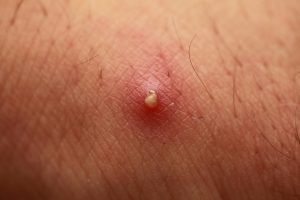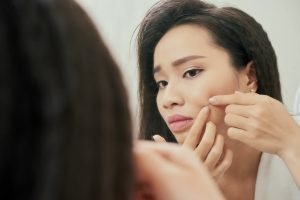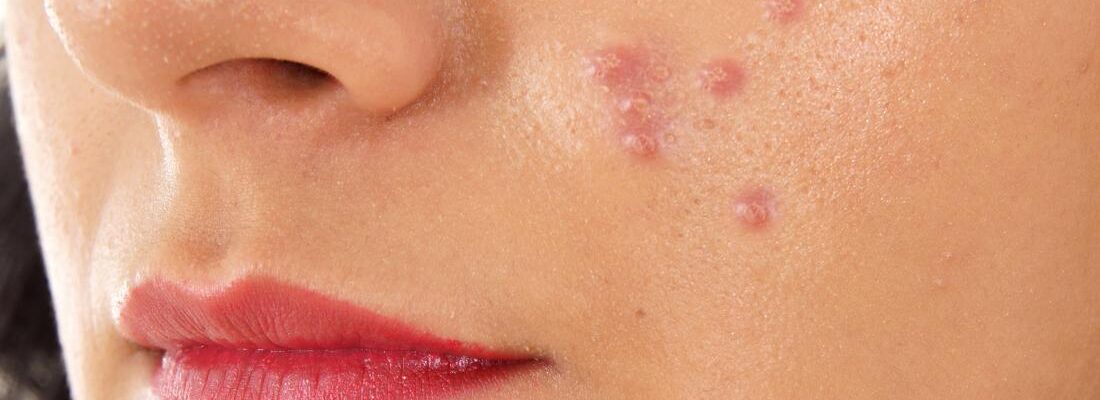Summary
Pimples, also known as acne, are small red bumps or black spots that commonly appear on the face, especially during puberty. It’s widely believed that pimples are a normal part of adolescence, as hormonal changes lead to increased oil production, which can clog pores and cause breakouts. However, acne is not limited to teenagers; many adults continue to struggle with pimples well into their 20s, 30s, or beyond.
There are many myths surrounding the causes of acne. Some claim it’s due to eating oily foods or indulging in too much chocolate. While diet can influence skin health, there is limited scientific evidence directly linking specific foods, like chocolate or greasy foods, to acne. Instead, acne results from a complex combination of factors, including genetics, hormones, and skin care habits.
Table of Contents
Symptoms of Pimples (Acne)
Acne symptoms manifest primarily on the skin, often varying in intensity and appearance. Key symptoms include:
- Red, inflamed bumps. Acne often appears as small, red bumps on the skin, which can become inflamed due to irritation and pore blockage.
- Pain or tenderness. Some pimples, especially larger ones, may feel sore or tender when touched due to inflammation and pressure under the skin.
- Pus-filled spots. Many pimples develop a white or yellowish center filled with pus, a sign that the immune system is responding to bacteria in clogged pores.
- Increased oiliness. Acne-prone skin may appear shinier or greasier due to excess production of sebum (oil), especially in areas like the forehead, nose, and chin.
- Visible blackheads or whiteheads. Small, visible spots may form on the skin’s surface, with blackheads appearing dark due to open pores and oxidation, and whiteheads staying light-colored as they remain closed.
These symptoms are typical of acne and can vary in frequency and severity. Individuals experiencing persistent or painful symptoms may benefit from targeted treatments to reduce inflammation and improve skin health.
Types of Pimples (Acne)

Image Source: www.medicalnewstoday.com
Acne can appear in various forms, each with distinct characteristics. These types of pimples vary in severity and depth within the skin, and understanding each type can help guide effective treatment.
- Whiteheads. Small, flesh-colored or white bumps that form when a pore is clogged with oil and dead skin cells but remains closed at the skin’s surface.
- Blackheads. Dark spots that occur when pores are clogged with oil and dead skin cells but are open to the air, causing oxidation and turning the surface dark.
- Papules. Small, red, inflamed bumps that do not contain pus. Papules develop when blocked pores become irritated, resulting in tender, red spots.
- Pustules. Red, inflamed bumps with a white or yellow center filled with pus. Pustules are often what people think of as “typical” pimples and are a result of infection in a blocked pore.
- Nodules. Large, hard, painful lumps that develop beneath the skin’s surface. Nodules are deep-rooted and can be challenging to treat, often requiring medical intervention.
- Cysts. Large, painful, pus-filled lumps that form deep within the skin. Cystic acne is the most severe form and carries a higher risk of scarring, often needing prescription treatment.
Each type of acne has different underlying causes and may respond better to specific treatments. Identifying the type of acne helps in choosing the most effective care plan to minimize symptoms and prevent complications.
Diagnostic Procedures for Pimples (Acne)
Diagnosing acne typically involves a physical examination and a review of the patient’s medical history. In most cases, dermatologists can identify acne by visually assessing the skin and determining its severity, but additional tests may be necessary to identify underlying causes or tailor treatment. Here are common diagnostic steps for acne:
- Medical history and physical exam. The dermatologist will examine the skin to assess the type and severity of acne, including the presence of whiteheads, blackheads, papules, pustules, nodules, or cysts. A review of the patient’s medical history, including any medications, lifestyle habits, and family history of acne, helps identify contributing factors.
- Hormonal testing (for adults and persistent acne). For cases of persistent or adult acne, especially in women, hormonal imbalances may be a cause. Blood tests to measure levels of androgens (male hormones) or other hormones can help identify conditions like polycystic ovary syndrome (PCOS) or hormonal fluctuations that could trigger acne.
- Skin swab or culture (for suspected infections). If acne is severe or presents signs of infection, such as pus or extreme inflammation, the doctor may take a sample from the skin to test for bacterial or fungal infections that might contribute to breakouts.
- Allergy testing (if suspected triggers exist). Some individuals may develop acne or acne-like symptoms in response to specific products, cosmetics, or environmental allergens. Allergy testing can identify these triggers, allowing for targeted skincare and lifestyle adjustments.
- Psychological assessment (for acne impact on mental health). Severe acne can affect self-esteem and mental health, so a dermatologist may discuss the emotional impact of acne and recommend counseling or support if needed, especially in adolescent patients.
Most cases of acne can be diagnosed visually, but additional tests can provide valuable insights in complicated cases or when standard treatments aren’t effective. This comprehensive approach helps dermatologists create personalized treatment plans that address both the visible symptoms and any underlying causes of acne.
Complications of Untreated Pimples (Acne)
When acne is left untreated, it can lead to a range of complications that affect both the skin and emotional well-being. The following are common complications of untreated acne:
- Scarring. Severe or prolonged acne, particularly cystic acne, can cause permanent scars as lesions damage deeper layers of the skin. These scars may appear as pits or raised areas and can be difficult to treat once formed.
- Dark spots and hyperpigmentation. After pimples heal, they often leave behind dark spots or patches of discoloration, known as post-inflammatory hyperpigmentation. These spots can take weeks, months, or even longer to fade, especially in individuals with darker skin tones.
- Skin infections. In some cases, untreated acne lesions may become infected with bacteria, leading to increased inflammation and potentially causing abscesses or larger skin infections that may require medical treatment.
- Psychological impact. Persistent acne can negatively affect self-esteem, leading to emotional stress, social anxiety, and even depression, particularly in adolescents and young adults. The visible nature of acne can lead individuals to feel self-conscious, which may affect quality of life.
- Worsening acne. Without proper treatment, acne can worsen over time. Clogged pores and inflammation can spread, resulting in more severe forms of acne that require intensive treatment to manage and may be more prone to complications.
Treating acne early can help prevent these complications, minimize skin damage, and reduce the emotional impact of acne. For those struggling with persistent or severe acne, consulting a dermatologist is recommended to develop an effective treatment plan.
Causes of Pimples (Acne)

Image Source: www.safeguard.ph
Acne is caused by a combination of factors that lead to clogged pores, inflammation, and, in some cases, bacterial growth. Understanding these causes can help with effective prevention and treatment.
- Excess oil (sebum) production. Sebaceous glands in the skin produce oil to keep it moisturized, but when excess sebum is produced, it can clog pores, leading to the formation of pimples.
- Clogged hair follicles. Dead skin cells that don’t shed naturally can combine with sebum, creating a sticky plug that blocks hair follicles (pores), leading to blackheads, whiteheads, and other acne lesions.
- Bacterial growth. Propionibacterium acnes (P. acnes) is a bacteria commonly found on the skin that can multiply in clogged pores, leading to inflammation and pustule or cyst formation.
- Hormonal changes. Fluctuations in hormones, particularly during puberty, menstruation, pregnancy, and stress, can increase oil production in the skin, making breakouts more likely.
- Certain medications. Some medications, including corticosteroids, lithium, and certain birth control methods, can contribute to acne development as a side effect.
- Diet. High-glycemic foods (such as sugary snacks and refined carbohydrates) and dairy products may contribute to acne in some individuals, though the exact relationship between diet and acne is still being researched.
- Genetics. Family history plays a role in acne; if parents had acne, children may be more likely to develop it as well due to inherited skin characteristics.
- Stress. While stress doesn’t directly cause acne, it can exacerbate symptoms by triggering hormonal responses that lead to increased oil production and inflammation.
Each of these factors can interact, making acne a complex condition with multiple contributing causes. Identifying and managing these underlying factors can help reduce breakouts and improve skin health.
Prevention of Pimples (Acne)
Preventing acne involves daily habits and lifestyle adjustments to reduce the factors that contribute to clogged pores, excess oil production, and inflammation. Here are effective strategies for preventing acne:
- Cleanse your skin gently. Wash your face twice daily with a mild cleanser to remove dirt, oil, and sweat without irritating the skin. Avoid harsh scrubbing, which can damage the skin barrier and worsen acne.
- Use non-comedogenic skincare and makeup products. Look for products labeled “non-comedogenic,” meaning they won’t clog pores. This can help prevent breakouts and keep your skin clear.
- Moisturize regularly. Even oily skin needs hydration. Use a lightweight, oil-free moisturizer to keep your skin balanced and prevent it from producing excess sebum.
- Avoid touching your face. Hands carry oil, dirt, and bacteria, which can transfer to your skin and lead to clogged pores and acne. Avoid picking or squeezing pimples, as this can worsen inflammation and lead to scarring.
- Limit sun exposure and use sunscreen. Sun damage can exacerbate acne and lead to dark spots. Use a non-comedogenic, oil-free sunscreen daily to protect your skin without clogging pores.
- Eat a balanced diet. While the link between diet and acne is still being studied, eating a diet rich in whole foods, fruits, vegetables, and lean proteins may help support healthy skin. Limiting high-glycemic foods and dairy could also help some individuals with acne-prone skin.
- Manage stress levels. Chronic stress can trigger hormonal changes that lead to acne. Practicing stress-reduction techniques, such as exercise, meditation, or deep breathing, can help keep your skin and overall health in check.
- Avoid excessive washing or exfoliating. Over-washing and excessive exfoliation can strip the skin of natural oils, leading to more oil production and irritation. Limit exfoliation to once or twice a week, using gentle products.
- Choose the right hair products. Hair products can transfer oils and chemicals to the skin, leading to breakouts, especially around the forehead and temples. Opt for oil-free, non-comedogenic hair products, and keep hair away from your face.
- Consider consulting a dermatologist. For persistent or severe acne, professional guidance can make a difference. A dermatologist can provide targeted treatments, such as topical or oral medications, to manage acne more effectively.
By following these preventive steps, individuals can help reduce the occurrence of acne and promote healthier, clearer skin.
Risk Factors for Pimples (Acne)
Certain factors increase the likelihood of developing acne by contributing to excess oil production, clogged pores, and inflammation. Understanding these risk factors can help with prevention and targeted treatment.
- Age and hormonal changes. Teenagers are particularly prone to acne due to the hormonal changes that occur during puberty. Hormonal shifts, such as those during menstruation, pregnancy, or menopause, can also trigger acne in adults.
- Family history. Genetics play a significant role in acne; if one or both parents had acne, there is a higher likelihood that their children will experience it as well.
- Oily or combination skin type. People with naturally oily or combination skin are more prone to acne since excess sebum can clog pores, leading to breakouts.
- Use of certain medications. Drugs like corticosteroids, lithium, and some forms of hormonal birth control can contribute to acne as a side effect.
- Diet high in refined sugars and dairy. Although research is ongoing, diets high in refined carbohydrates (like sugary snacks) and dairy have been linked to a higher incidence of acne in some individuals, possibly due to their impact on insulin and other hormones.
- Frequent friction or pressure on the skin. Wearing tight clothing, sports equipment (like helmets and straps), or face masks can create friction that irritates the skin, contributing to acne, especially in the areas where pressure is applied.
- Use of comedogenic products. Skin and hair products that contain oils or other pore-clogging ingredients can lead to breakouts, particularly in individuals prone to acne.
- Stress. While stress itself doesn’t cause acne, it can worsen symptoms by triggering hormonal responses that increase oil production and inflammation.
- Exposure to pollutants and high humidity. Environmental factors like pollution and humid weather can irritate the skin, leading to clogged pores and increased oil production.
Being aware of these risk factors allows for better management of acne and a more tailored approach to prevention and treatment. Those with multiple risk factors may benefit from consulting a dermatologist for personalized skincare advice and support.
Pimples (Acne) FAQs
Here are answers to some frequently asked questions about pimples and acne to help you understand this common skin condition and how to manage it effectively.
- What is acne?
Acne is a skin condition that occurs when hair follicles become clogged with oil, dead skin cells, and sometimes bacteria, leading to pimples, blackheads, whiteheads, or more severe lesions like nodules and cysts. - What causes acne?
Acne results from a combination of excess oil production, clogged pores, bacterial growth, and, in many cases, hormonal changes. Genetics, lifestyle factors, and certain medications can also contribute to acne. - What are the common symptoms of acne?
Symptoms include red, inflamed bumps (papules and pustules), whiteheads, blackheads, painful cysts, and, in severe cases, nodules. Acne can appear on the face, chest, back, shoulders, and other areas. - Can acne be prevented?
While it may not be possible to prevent acne entirely, good skincare habits, using non-comedogenic products, avoiding excessive sun exposure, and managing stress can help reduce breakouts. For those with persistent acne, consulting a dermatologist can provide additional preventive strategies. - Does diet affect acne?
Research suggests that high-glycemic foods (sugary snacks and refined carbs) and dairy products may worsen acne in some people. A balanced diet rich in whole foods, lean proteins, and fruits and vegetables can support overall skin health, although diet alone is not a cure for acne. - How is acne diagnosed?
Dermatologists diagnose acne through a physical examination of the skin and may review medical history to determine contributing factors. In some cases, additional tests, such as hormone testing or skin swabs, are used to identify underlying causes. - Can acne leave scars?
Yes, untreated or severe acne can lead to scarring, especially cystic or nodular acne. Scars may appear as pits, raised areas, or discoloration, and they are often more challenging to treat than acne itself. - Is acne only a teenage problem?
No, acne can affect individuals of all ages. While it is more common in teenagers due to hormonal changes, many adults experience acne well into their 20s, 30s, and even later in life due to factors like stress, hormones, or lifestyle. - What are the treatment options for acne?
Treatment options include topical treatments (like benzoyl peroxide, retinoids, or salicylic acid), oral medications (antibiotics, hormonal treatments, or isotretinoin for severe cases), and lifestyle modifications. Consulting a dermatologist is often the best approach for determining an effective treatment plan. - Does stress cause acne?
While stress doesn’t directly cause acne, it can worsen symptoms by triggering hormonal responses that increase oil production and inflammation. Managing stress can be a helpful part of an overall acne treatment plan.


